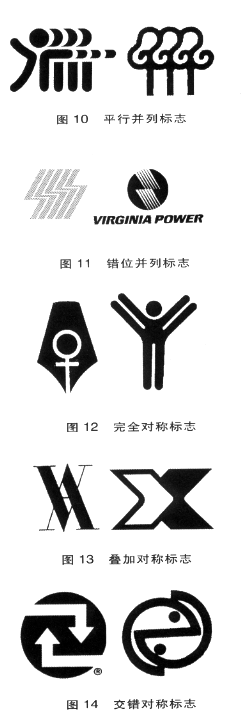3 Repeated basic form of application
1) Side by side
The mark formed by repeating the basic shape in a straight line, oblique line, or curve is a parallel type. Side by side can use two or more basic shapes to arrange. The form of the repetitive basic forms formed by the parallelism is unified and the image is consistent and has a good sense of order. Parallelism has parallel parallelism and misalignment. Parallel juxtaposition refers to the horizontal displacement of the repeated basic shape in the horizontal direction. The mark formed by it visually gives the effect of extending the figure and increases the interest of the sign. The sign of Figure 10 strongly illustrates this point. The sign formed by dislocation parallelism is richer than parallel juxtaposition, which increases the dynamic of the sign. Take Figure 11 as an example.

2) Symmetrical
Repetition of basic form Symmetrically symmetrical or point-symmetrical forms are symmetrical. Symmetrical repetitive primitives can use overlapping, transposed, or staggered to increase the liveliness of the logo, seeking change in the same repeating basic form, and breaking the one-to-one correspondence of the lack of change in the psychological experience. Symmetry can be divided into completely symmetrical, superimposed symmetry and staggered symmetry. Figure 12 The completely symmetric logo has a strict, orderly sense of order and presents a quiet, peaceful, simple beauty. The superimposed symmetry logo in FIG. 13 is more varied in form than complete symmetry, and the repetition of the basic shape changes the logo reiki, enhances the visibility of the logo, and increases the joy of change in a symmetric form. The staggered symmetry logo in Fig. 14 forms an interesting graphic that is mutually fused and mutually existing. This symmetry form is often adopted by designers.
3) Rotary
The symbol that is formed by rotating the basic shape at a certain point as a common point is a rotary type. Rotary type can use 3 or more basic shapes to rotate according to a certain angle and direction. The angle of rotation can be equal angle or gradient angle. The basic form can be from small to large, from dense to sparse, gradually outward from the center of the rotation, diffusion, forming a beautiful proportional relationship and strong rhythm. The rotary logo has equal distance rotation and gradient rotation, respectively. The equidistant rotation logo (Figure 15) is full and full and harmonious and graceful; the gradient rotation logo (Figure 16) is vivid and smooth, with strong rhythm and rhythm. Rotary style contains extremely rich beauty factors. The growth structure of many organisms in nature is a perfect embodiment of a rotating type, such as a nest, a nautilus spiral shell, sunflower sunflower seeds and pine pine nuts.

(to be continued)